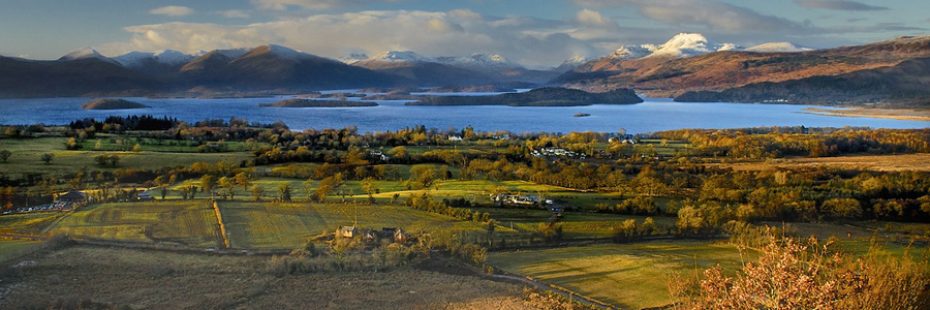
Loch Lomond
The largest inland stretch of water in Britain, Loch Lomond is one of the most popular destinations in Scotland. The loch, which famously features in the song ‘The Bonnie Banks o’ Loch Lomond’, extends north for 24 miles from Balloch, popularly known as an access point to the Highlands.
The Highland Boundary Fault traverses the loch from east to west, from Conic Hill to Ben Bowie. The geological line provides a distinctive contrast of scenery from the Lowlands in the south to the Highlands in the north. Read more about it here.
The main A82 road offers easy access to villages and viewpoints along the west side of the loch, such as Luss, Arden, Firkin Point and Tarbet. Hugging the same shoreline, from Balloch to Tarbet, is a traffic-free cycle route, the West Loch Lomond Cycle Path.
To the east, a narrower road runs between Balmaha and Rowardenan, which is a popular setting off point for those climbing Ben Lomond, Scotland’s most southerly Munro. Past the road end, a walking and cycling trail travels to the northern end of the loch. This route is part of the famous West Highland Way.
There are many places to stop for a walk or picnic with beautiful loch and mountain views. Highly recommended is a short but scenically rewarding hike to the top of Conic Hill from Balmaha, as well as the Balmaha Millennium Forest Path and Sallochy Forest Trails.

Loch Lomond seen from The Dumpling
The loch is also home to over 30 small islands, including Inchmurrin, Britain’s largest fresh-water island, and Inchcailloch, which may not be the largest, but it is the most accessible. A ferry and a waterbus transport visitors to the island. Part of a National Nature Reserve, Inchcailloch boasts pretty woodlands and some great waymarked walking trails with superb views out across the loch. You can also camp overnight on the island (see map below).
There is a huge array of activities to enjoy on or close to Loch Lomond, including watersports such as kayaking, Canadian canoes, stand-up paddle boards, wake boarding, water skiing and wake surfing. Loch Lomond is also very popular with swimmers and plays host to a number of open water swimming events.
To the south is the leisure and retail outlet, Loch Lomond Shores, which is a great hub for shopping, eating and family activities.
The North Loch Lomond area is characterised by a vast and open sense of place and long dramatic vistas. The forests and woodlands along the loch shores contrast with the surrounding uplands to create a landscape of high scenic value. The upland hills surrounding Loch Loch Lomond, which include Ben Lomond and Ben Vorlich, provide a dramatic backdrop to the loch. They are largely undeveloped and have an open and wild sense of place.
There is a large area of Atlantic oak woodland that surrounds much of the loch and covers many of its islands, supporting a rich and varied lower plant community. The uplands are of high importance for a range of montane and upland plant communities and associated invertebrates. Ben Lomond and Ben Vorlich are also designated as SSSIs (Sites of Special Scientific Interest). Species include black grouse, ptarmigan, upland waders, eagle, pine marten, red deer, mountain hare and water vole.
Make a stay of it
Whether you’re looking for the comfort of a campsite or the solitude of ‘wild camping’, the National Park offers plenty of places to immerse yourself in some of the most spectacular scenery in Scotland.
If you are planning to ‘wild camp’, be aware that seasonal byelaws came into effect on 1st March 2017 which affect how you can camp in some areas between March and September. During this time, you need a permit to camp or (in some locations) to stay overnight in your motorhome in these Camping Management Zones.
Explore our map to find your perfect spot

